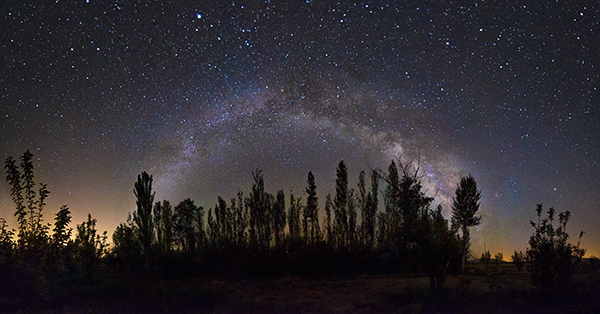
Glowing Serpent Found in the Sky
Astronomers have discovered a star generating a pinwheel of dust 8,000 lightyears away, which may shed some light on the last stages of massive star evolution.

Pattern in Milky Way's Stars Suggests Recent Galactic Whack
An unexpected pattern in the Milky Way's disk of stars points to a recent whack from another galaxy.

Astronomers "Weigh" Beta Pictoris b
Astronomers have a precise new mass measurement for Beta Pictoris b, a young gas giant still in the throes of formation 63 light-years from Earth.

Auroras Discovered Around Rogue Brown Dwarf
Astronomers have discovered auroras around a set of brown dwarfs — including one that wanders the galaxy by itself — indicating surprisingly strong magnetic fields in these failed stars.

New Observations of the "Most Mysterious Star in the Galaxy"
New data on Boyajian's Star show that dust — not an alien megastructure — is probably the cause of this star's mysterious behavior.

Planet Orbits Quiet Star 11 Light-years Away
Astronomers have discovered a potentially rocky planet around a red dwarf star just 11 light-years away.

Cool Dust — and More Planets? — for Proxima Centauri
Tantalizing new observations hint that there's a lot more going on in the Proxima Centauri system — the one that hosts the exoplanet nearest Earth — than meets the eye.

Best Exomoon Candidate Yet?
Astronomers have found one of the best exomoon candidates in data collected by the Kepler spacecraft.

100 Billion Brown Dwarfs in the Milky Way?
A new study of a nearby cluster of newly formed stars reveals that brown dwarfs may rival stars in the Milky Way in number, with one brown dwarf for every two bona fide stars.

Help Astronomers Track a Giant, Ringed Planet
The possible discovery of a massive ringed planet in Orion needs confirmation — and amateur astronomers can help.

Brown Dwarfs Mimic Their Big Stellar Siblings
Two recent studies suggest that brown dwarfs, or so-called “failed stars,” are nevertheless more like stars than planets.

Origin of Our Galaxy's Most Distant Stars
The most distant stars discovered in the Milky Way might have been ripped away from a companion galaxy.

Milky Way's New Neighbor: A Giant Dwarf
Astronomers have discovered a “feeble giant”: one of the largest dwarf galaxies ever seen around the Milky Way.

Star-Counting in the Galactic Bulge
Astronomers have taken a careful census of the smallest stars in our galaxy’s center.

Seeing Spots on a Red Giant Star
Astronomers have gathered enough observations to produce an exquisite image of another star’s surface.

Brown Dwarfs Form Like Stars
Recent radio observations support the idea that brown dwarfs form like full-fledged stars do.

Planet with a Comet Tail
Astronomers have confirmed that the planet Gliese 436b seems to be trailing a gigantic, comet-like cloud of hydrogen.

Gap Reveals Potential Exomoon
Astronomers have confirmed that the star J1407 seems to have a companion with a gigantic, gap-ridden ring, inside which an “exomoon” might be forming.

Stars' Spins Show Their Ages
Astronomers have expanded their ability to date stars using the stars’ own spins.

Next-Gen Adaptive Optics
The Subaru Telescope has donned a new pair of glasses called Raven, a multi-object adaptive optics system that enables astronomers to correct for atmospheric turbulence over an unprecedented field of view.
